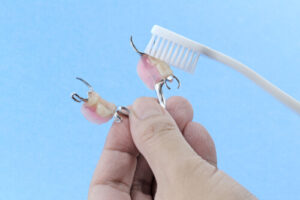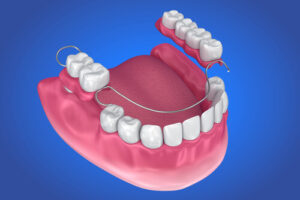In dentistry, some solutions bridge the gap between tooth loss and the final restoration, ensuring that individuals can continue to smile, speak, and eat with confidence. One such solution is the interim partial denture. This dental device, while temporary, plays a pivotal role in the journey to a restored smile. But what exactly is an interim partial denture, and why might one need it? As we delve into this topic, prepare to uncover the nuances and intricacies of this often-overlooked dental marvel and the profound difference it can make in the lives of many.
Stay with us as we embark on a journey that promises to reveal the transformative power of the interim partial denture.
What are the interim removable partial dentures

Interim removable partial dentures, often called interim partials, are temporary prosthetic devices used to replace one or more missing teeth for a short period.
Typically made of acrylic resin, these dentures serve multiple purposes: they maintain space, prevent adjacent teeth from shifting, aid in chewing, and offer an aesthetic solution until a definitive prosthetic replacement, like a permanent bridge or implant, is ready for placement.
Designed for short-term use, interim partials are an essential tool in the transitional phase of dental restoration.
Uses of interim removable partial denture
The realm of dentistry offers a myriad of solutions tailored to address the unique needs of every patient’s dentition. Among these, the interim removable partial denture stands out as a versatile and cost-effective tool. Here’s a detailed look into its uses:
- Temporary Replacement: The primary use of the interim removable partial denture is to act as a temporary prosthesis during the transitional phase between tooth extraction and the placement of a definitive prosthesis. This ensures patients don’t have to navigate daily life with missing teeth.
- Aesthetic Solution: Beyond mere functionality, these dentures offer an esthetic solution. They fill the gaps left by missing tooth or teeth, ensuring that the patient’s smile remains intact during the treatment phase.
- Facilitate Healing: Post extraction, the gums and mouth undergo a healing process. The interim partials play a pivotal role in protecting the extraction site from trauma, ensuring optimal healing conditions.
- Maintaining Space: One of the many advantages of interim partials is their ability to maintain the space left by the missing tooth or teeth. This prevents adjacent teeth from shifting, preserving the integrity of the patient’s dentition.
- Speech and Function: Missing teeth can impact speech and chewing function. The interim removable partial denture helps restore these functions temporarily, ensuring that patients can speak and eat with minimal disruption.
- Preparation for Permanent Solution: These dentures are a precursor to permanent solutions like bridges or implants. They allow the dentist to gauge the patient’s comfort, make necessary adjustments, and ensure that the final prosthesis will be a perfect fit.
- Cost-effective: Compared to immediate dentures or conventional methods, interim partials offer a cost-effective solution for patients awaiting a permanent dental prosthesis.
Essentially, the interim removable partial denture is a crucial tool in the dentist’s arsenal. Its ability to offer temporary solutions, combined with its many advantages, ensures that patients can continue their journey toward perfect oral health with complete confidence and comfort. Whether it’s to maintain the shape and function of the mouth or to facilitate the healing process post-extraction, these dentures are indispensable in modern dental treatment.
What is the difference between a partial denture and an interim partial denture?
In the vast landscape of dental prosthetics, understanding the nuances between different types of devices is crucial for both patients and practitioners. Two commonly discussed devices in this realm are the partial denture and the interim partial denture. While they might sound similar, they serve distinct purposes and have unique characteristics:
- Purpose and Duration of Use: A partial denture is designed as a long-term solution for missing teeth. It’s crafted to be durable and can be worn for several years. On the other hand, an interim partial denture, as the name suggests, is a temporary solution. It’s used during the transitional phase, often between tooth extraction and the placement of a permanent prosthesis or while waiting for the gums and mouth to heal.
- Material Composition: While both types of dentures can be made from various materials, partial dentures are often more robust and might include a combination of acrylic and metal for added strength. Interim partials, in contrast, are typically made entirely of acrylic, making them lighter but less durable.
- Aesthetic and Functional Considerations: Partial dentures are meticulously crafted to match the patient’s dentition in color, shape, and function. They are meant to integrate with the existing teeth seamlessly. Interim partials, being temporary, might have a different level of aesthetic refinement but serve the essential function of filling gaps and aiding in speech and chewing.
- Cost and Fabrication Time: Given their temporary nature, interim removable partial dentures are generally more cost-effective and quicker to fabricate than their long-term counterparts. Partial dentures, due to their detailed customization and durable materials, might require a longer fabrication time and can be more expensive.
- Adjustment and Maintenance: Interim partials might require more frequent adjustments, given their temporary role and the ongoing changes in the patient’s mouth post-extraction or other treatments. Partial dentures, once fitted, require regular maintenance but less frequent adjustments.
In summary, while both the partial denture and the interim partial denture play pivotal roles in restoring a patient’s lost smile and function, they differ significantly in terms of purpose, durability, aesthetics, cost, and maintenance. Recognizing these differences ensures that patients receive the most appropriate treatment for their specific dental needs.
Candidates of interim removable partial denture

Navigating the world of dental prosthetics can be intricate, and understanding who is best suited for specific treatments is paramount. When it comes to the interim removable partial denture, only some patients are ideal candidates. Let’s delve into the specific scenarios and characteristics that make an individual a suitable candidate for this temporary dental solution:
- Post-Extraction Phase: One of the primary candidates for an interim partial denture is a patient who has recently undergone tooth extraction. The interim denture serves as a temporary placeholder, ensuring that the patient doesn’t have to endure the inconvenience of missing teeth while awaiting a permanent solution.
- Awaiting Dental Implants or Bridges: Patients in the preparatory stages for receiving dental implants or bridges often benefit from interim partials. These dentures ensure that the patient’s dentition remains stable and the space for the future prosthesis is maintained.
- Healing Gums and Tissues: Individuals who have undergone dental surgeries or treatments that require the gums and oral tissues to heal can benefit from interim removable partial dentures. These dentures protect the healing areas from trauma and facilitate a smoother recovery.
- Cost Considerations: For patients who might not immediately afford a permanent dental solution, interim partials offer a cost-effective temporary alternative. This ensures that they can maintain function and aesthetics while they plan for a long-term solution.
- Evaluating Comfort and Fit: Before committing to a permanent prosthesis, some patients opt for interim partials to gauge their comfort with a dental appliance. It allows the patient and the dentist to make necessary adjustments and ensures that the final prosthesis will be a perfect fit.
- Patients with Fluctuating Dental Health: Individuals whose dental health is in flux, perhaps due to conditions like periodontal disease, might be advised to opt for interim partials. This provides a flexible solution that can be easily adjusted or replaced as the patient’s dental condition evolves.
In essence, the interim removable partial denture is a versatile tool in the dentist’s arsenal, catering to a wide range of patients. Whether it’s a transitional phase, a healing period, or a comfort trial, these dentures play a pivotal role for dentists in ensuring that candidates receive the care and functionality they need during specific phases of their dental journey.
Disadvantages of interim removable partial denture
While interim removable partial dentures offer a myriad of benefits, it’s essential to approach them with a comprehensive understanding of their limitations. As with any medical or dental solution, they come with their own set of disadvantages that both patients and practitioners should be aware of. Let’s delve into the potential drawbacks of opting for these temporary dental prosthetics:
- Durability Concerns: Given their temporary nature, interim removable partial dentures are less durable than their permanent counterparts. They are typically made of materials like acrylic, which might not withstand the wear and tear of daily use over extended periods.
- Potential for Discomfort: Some patients might experience discomfort or irritation, especially during the initial days of wearing the interim denture. This could be due to the fit or the sensitivity of the gums post-extraction or surgery.
- Aesthetic Limitations: While interim dentures aim to restore aesthetics, permanent prosthetics might match the natural teeth less seamlessly than they are. The color, shape, or fit might be less refined, leading to potential aesthetic discrepancies.
- Frequent Adjustments Required: Due to the changes in the mouth post-extraction or other dental procedures, interim dentures might require more frequent adjustments to ensure a comfortable fit.
- Potential for Accidental Dislodgement: Given that they are removable and not anchored like permanent solutions, there’s a possibility of the denture becoming dislodged during activities like eating or speaking.
- Maintenance and Hygiene: Interim removable partial dentures require diligent care and cleaning to prevent bacterial buildup and potential infections. This might be cumbersome for some patients.
- Not a Long-term Solution: Patients must understand that interim dentures are a temporary measure. Relying on them as a long-term solution could lead to complications or not address underlying dental issues adequately.
In essence, while interim removable partial dentures play a crucial role in the transitional phases of dental care, they come with their own set of challenges. Being informed about these limitations ensures that patients can make well-rounded decisions about their dental health, optimizing outcomes and minimizing potential complications.
Conclusion
In the ever-evolving landscape of dental care, the interim partial denture stands out as a pivotal tool for those navigating the transitional phases of oral health. While it offers a temporary solution, its significance in maintaining aesthetics, function, and overall dental well-being cannot be understated. As with any dental solution, understanding its benefits and limitations is key.
Ultimately, the interim partial or denture tooth also serves as a testament to modern dentistry’s commitment to ensuring that patients never compromise on their smiles, even momentarily. As we advance in dental technology and techniques, the role of such interim solutions remains indispensable, bridging the gap between immediate needs and long-term dental aspirations.
References
What is a Temporary Partial Denture?
https://www.webmd.com/oral-health/what-is-a-temporary-partial-denture
Single appointment interim partial denture for a patient with a self-maintained provisional
https://pubmed.ncbi.nlm.nih.gov/24983165/
A Technique to Fabricate a Customized Interim Removable Partial Denture
https://www.sciencedirect.com/science/article/pii/S0022391309601451
In-office fabrication of a claspless interim partial denture
https://nyuscholars.nyu.edu/en/publications/in-office-fabrication-of-a-claspless-interim-partial-denture
Direct Fiber-Reinforced Interim Fixed Partial Dentures: Six-Year Survival Study
https://onlinelibrary.wiley.com/doi/abs/10.1111/jopr.12751


